NURSING STUDY
Improve your grades.
- 21
- 0
- 0
Community
- Followers
- Following
21 items

LATEST PHYSICAL EXAMINATION AND HEALTH ASSESSMENT QUESTIONS AND ANSWERS WITH RATIONALES UPDATED 2024-2025 RATED A+.
Table of Contents Table of Contents 1 Chapter 01: Evidence-Based Assessment Chapter 02: Cultural Assessment Chapter 03: The Interview Chapter 04: The Complete Health History Chapter 05: Mental Status Assessment Chapter 06: Substance Use Assessment Chapter 07: Domestic and Family Violence Assessment Chapter 08: Assessment Techniques and Safety in the Clinical Setting Chapter 09: General Survey and Measurement Chapter 10: Vital Signs Chapter 11: Pain Assessment Chapter 12: Nutrition...
- Exam (elaborations)
- • 16 pages •
Table of Contents Table of Contents 1 Chapter 01: Evidence-Based Assessment Chapter 02: Cultural Assessment Chapter 03: The Interview Chapter 04: The Complete Health History Chapter 05: Mental Status Assessment Chapter 06: Substance Use Assessment Chapter 07: Domestic and Family Violence Assessment Chapter 08: Assessment Techniques and Safety in the Clinical Setting Chapter 09: General Survey and Measurement Chapter 10: Vital Signs Chapter 11: Pain Assessment Chapter 12: Nutrition...
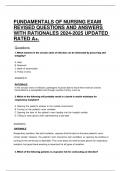
FUNDAMENTALS OF NURSING EXAM REVISED QUESTIONS AND ANSWERS WITH RATIONALES 2024-2025 UPDATED RATED A+.
Questions 1. Which element in the circular chain of infection can be eliminated by preserving skin integrity? A. Host B. Reservoir C. Mode of transmission D. Portal of entry ANSWER D. RATIONALE In the circular chain of infection, pathogens must be able to leave their reservoir and be transmitted to a susceptible host through a portal of entry, such as 2. Which of the following will probably result in a break in sterile technique for respiratory isolation? A. Opening the pati...
- Exam (elaborations)
- • 22 pages •
Questions 1. Which element in the circular chain of infection can be eliminated by preserving skin integrity? A. Host B. Reservoir C. Mode of transmission D. Portal of entry ANSWER D. RATIONALE In the circular chain of infection, pathogens must be able to leave their reservoir and be transmitted to a susceptible host through a portal of entry, such as 2. Which of the following will probably result in a break in sterile technique for respiratory isolation? A. Opening the pati...

TEST BANK FOR NURSING PHARMACOLOGY QUESTONS AND ANSWERS WITH RATIONALE, ALL CHAPTERS UPDATED VERSION 2024-2025 RATED A+.
Table of Contents Chapter 01- Introduction to Drugs Chapter 02- Drugs and the Body Chapter 03- Toxic Effects of Drugs Chapter 04- The Nursing Process in Drug Therapy and Patient Safety Chapter 05- Dosage Calculations Chapter 06- Challenges to Effective Drug Therapy Chapter 07- Introduction to Cell Physiology Chapter 08- Anti-infective Agents Chapter 09- Antibiotics Chapter 10- Antiviral Agents Chapter 11- Antifungal Agents Chapter 12- Antiprotozoal Agents Chapter 13- Anthelmintic Agents C...
- Exam (elaborations)
- • 49 pages •
Table of Contents Chapter 01- Introduction to Drugs Chapter 02- Drugs and the Body Chapter 03- Toxic Effects of Drugs Chapter 04- The Nursing Process in Drug Therapy and Patient Safety Chapter 05- Dosage Calculations Chapter 06- Challenges to Effective Drug Therapy Chapter 07- Introduction to Cell Physiology Chapter 08- Anti-infective Agents Chapter 09- Antibiotics Chapter 10- Antiviral Agents Chapter 11- Antifungal Agents Chapter 12- Antiprotozoal Agents Chapter 13- Anthelmintic Agents C...
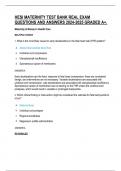
HESI MATERNITY TEST BANK REAL EXAM QUESTIONS AND ANSWERS WITH RATIONALES 2024-2025 GRADED A+.
HESI MATERNITY TEST BANK REAL EXAM QUESTIONS AND ANSWERS GRADED A+. Maternity & Women’s Health Care MULTIPLE CHOICE 1. What is the most likely cause for early decelerations in the fetal heart rate (FHR) pattern? a. Altered fetal cerebral blood flow b. Umbilical cord compression c. Uteroplacental insufficiency d. Spontaneous rupture of membranes ANSWER:A Early decelerations are the fetus’ response to fetal head compression; these are considered benign, and interventions are not nece...
- Exam (elaborations)
- • 67 pages •
HESI MATERNITY TEST BANK REAL EXAM QUESTIONS AND ANSWERS GRADED A+. Maternity & Women’s Health Care MULTIPLE CHOICE 1. What is the most likely cause for early decelerations in the fetal heart rate (FHR) pattern? a. Altered fetal cerebral blood flow b. Umbilical cord compression c. Uteroplacental insufficiency d. Spontaneous rupture of membranes ANSWER:A Early decelerations are the fetus’ response to fetal head compression; these are considered benign, and interventions are not nece...
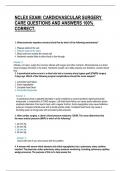
NCLEX EXAM: CARDIOVASCULAR SURGERY CARE QUESTIONS AND ANSWERS WITH RSTIONALES 100% CORRECT.
1. Atherosclerosis impedes coronary blood flow by which of the following mechanisms? 1. Plaques obstruct the vein 2. Plaques obstruct the artery 3. Blood clots form outside the vessel wall 4. Hardened vessels dilate to allow blood to flow through Answer: 2. Arteries, not veins, supply the coronary arteries with oxygen and other nutrients. Atherosclerosis is a direct result of plaque formation in the artery. Hardened vessels can’t dilate properly and, therefore, constrict blood flow. 2...
- Exam (elaborations)
- • 6 pages •
1. Atherosclerosis impedes coronary blood flow by which of the following mechanisms? 1. Plaques obstruct the vein 2. Plaques obstruct the artery 3. Blood clots form outside the vessel wall 4. Hardened vessels dilate to allow blood to flow through Answer: 2. Arteries, not veins, supply the coronary arteries with oxygen and other nutrients. Atherosclerosis is a direct result of plaque formation in the artery. Hardened vessels can’t dilate properly and, therefore, constrict blood flow. 2...

ENDOCRINE NCLEX PN PRACTICE QUESTIONS II AND ANSWERS RATED A+.
Question 1 A thirty-five-year-old male has been an insulin-dependent diabetic for five years and now is unable to urinate. Which of the following would you most likely suspect? A: Atherosclerosis B: Diabetic nephropathy C: Autonomic neuropathy D: Somatic neuropathy 1 Answer C. Autonomic neuropathy can cause inability to urinate. Question 2 A patient’s chart indicates a history of hyperkalemia. Which of the following would you not expect to see with this ...
- Exam (elaborations)
- • 40 pages •
Question 1 A thirty-five-year-old male has been an insulin-dependent diabetic for five years and now is unable to urinate. Which of the following would you most likely suspect? A: Atherosclerosis B: Diabetic nephropathy C: Autonomic neuropathy D: Somatic neuropathy 1 Answer C. Autonomic neuropathy can cause inability to urinate. Question 2 A patient’s chart indicates a history of hyperkalemia. Which of the following would you not expect to see with this ...
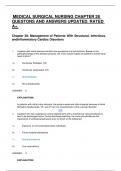
MEDICAL SURGICAL NURSING CHAPTER 28 QUESTONS AND ANSWERS UPDATED. RATED A+.
Chapter 28: Management of Patients With Structural, Infectious, andInflammatory Cardiac Disorders 1. A patient with mitral stenosis exhibits new symptoms of a dysrhythmia. Based on the pathophysiologyof this disease process, the nurse would expect the patient to exhibit what heart rhythm? A) Ventricular fibrillation (VF) B) Ventricular tachycardia (VT) C) Atrial fibrillation D) Sinus bradycardia ANSWER: C EXPLANATION: In patients with mitral valve stenosis, the pulse is weak and often...
- Exam (elaborations)
- • 20 pages •
Chapter 28: Management of Patients With Structural, Infectious, andInflammatory Cardiac Disorders 1. A patient with mitral stenosis exhibits new symptoms of a dysrhythmia. Based on the pathophysiologyof this disease process, the nurse would expect the patient to exhibit what heart rhythm? A) Ventricular fibrillation (VF) B) Ventricular tachycardia (VT) C) Atrial fibrillation D) Sinus bradycardia ANSWER: C EXPLANATION: In patients with mitral valve stenosis, the pulse is weak and often...
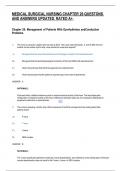
MEDICAL SURGICAL NURSING CHAPTER 26 QUESTONS AND ANSWERS UPDATED. RATED A+.
Chapter 26: Management of Patients With Dysrhythmias and Conduction Problems 1. The nurse is caring for a patient who has had an ECG. The nurse notes that leads I, II, and III differ from one another on the cardiac rhythm strip. How should the nurse best respond? A) Recognize that the view of the electrical current changes in relation to the lead placement. B) Recognize that the electrophysiological conduction of the heart differs with lead placement. C) Inform the technician that the ECG eq...
- Exam (elaborations)
- • 19 pages •
Chapter 26: Management of Patients With Dysrhythmias and Conduction Problems 1. The nurse is caring for a patient who has had an ECG. The nurse notes that leads I, II, and III differ from one another on the cardiac rhythm strip. How should the nurse best respond? A) Recognize that the view of the electrical current changes in relation to the lead placement. B) Recognize that the electrophysiological conduction of the heart differs with lead placement. C) Inform the technician that the ECG eq...
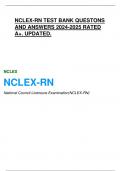
NCLEX-RN TEST BANK QUESTONS AND ANSWERS WITH RATIONALES, VERIFIED NEWEST VERSION RATED A+.
QN:1 On the third postpartum day, the nurse would expect the lochia to be: A. Rubra B. Serosa C. Alba D. Scant ANS:A RATIONALES: (A) This discharge occurs from delivery through the 3rd day. There is dark red blood, placental debris, and clots. (B) This discharge occurs from days 4-10. The lochia is brownish, serous, and thin. (C) This discharge occurs from day 10 through the 6thweek. The lochia is yellowish white. (D) This is not a classification of lochia but relates to the amount of di...
- Exam (elaborations)
- • 573 pages •
QN:1 On the third postpartum day, the nurse would expect the lochia to be: A. Rubra B. Serosa C. Alba D. Scant ANS:A RATIONALES: (A) This discharge occurs from delivery through the 3rd day. There is dark red blood, placental debris, and clots. (B) This discharge occurs from days 4-10. The lochia is brownish, serous, and thin. (C) This discharge occurs from day 10 through the 6thweek. The lochia is yellowish white. (D) This is not a classification of lochia but relates to the amount of di...
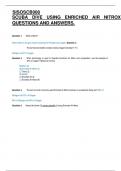
SISOSCB008 SCUBA DIVE USING ENRICHED AIR NITROX QUESTIONS AND ANSWERS.
Question 1. What is Nitrox? Nitrox refers to any gas mixture composed of nitrogen and oxygen. Question 2. The air that we breathe consists mainly of (approximately)? 78% Nitrogen and 21% Oxygen. Question 3. What terminology is used to describe Enriched Air Nitrox and composition, use the example of 32% of oxygen? (Select all correct) Nitrox 32 Enriched Air Nitrox 32 Trimix 32 EAN32 Enriched Air 32 Enriched Air Nitrox 68 Question 4. The two (2) most commonly used Enriched air N...
- Exam (elaborations)
- • 8 pages •
Question 1. What is Nitrox? Nitrox refers to any gas mixture composed of nitrogen and oxygen. Question 2. The air that we breathe consists mainly of (approximately)? 78% Nitrogen and 21% Oxygen. Question 3. What terminology is used to describe Enriched Air Nitrox and composition, use the example of 32% of oxygen? (Select all correct) Nitrox 32 Enriched Air Nitrox 32 Trimix 32 EAN32 Enriched Air 32 Enriched Air Nitrox 68 Question 4. The two (2) most commonly used Enriched air N...
